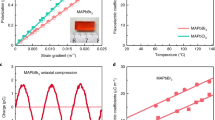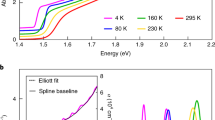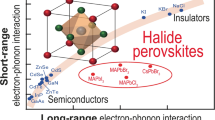Abstract
Lead halide perovskites have demonstrated outstanding performance in photovoltaics, photodetectors, radiation detectors and light-emitting diodes. However, the electromechanical properties, which are the main application of inorganic perovskites, have rarely been explored for lead halide perovskites. Here, we report the discovery of a large electrostrictive response in methylammonium lead triiodide (MAPbI3) single crystals. Under an electric field of 3.7 V µm−1, MAPbI3 shows a large compressive strain of 1%, corresponding to a mechanical energy density of 0.74 J cm−3, comparable to that of human muscles. The influences of piezoelectricity, thermal expansion, intrinsic electrostrictive effect, Maxwell stress, ferroelectricity, local polar fluctuation and methylammonium cation ordering on this electromechanical response are excluded. We speculate, using density functional theory, that electrostriction of MAPbI3 probably originates from lattice deformation due to formation of additional defects under applied bias. The discovery of large electrostriction in lead iodide perovskites may lead to new potential applications in actuators, sonar and micro-electromechanical systems and aid the understanding of other field-dependent material properties.
This is a preview of subscription content, access via your institution
Access options
Access Nature and 54 other Nature Portfolio journals
Get Nature+, our best-value online-access subscription
$29.99 / 30 days
cancel any time
Subscribe to this journal
Receive 12 print issues and online access
$259.00 per year
only $21.58 per issue
Buy this article
- Purchase on Springer Link
- Instant access to full article PDF
Prices may be subject to local taxes which are calculated during checkout



Similar content being viewed by others
Data availability
The authors declare that all relevant data supporting the findings of this study are available within the paper and its Supplementary Information.
Change history
12 October 2018
In the version of this Article originally published, the y axis of Fig. 1c was incorrectly labelled ‘S (%)’; it should have been ‘–S (%)’. Also, the link for the Supplementary Video was missing from the online version of the Article. These errors have now been corrected.
References
Yang, W. S. et al. Iodide management in formamidinium-lead-halide-based perovskite layers for efficient solar cells. Science 356, 1376–1379 (2017).
NREL Best research-cell efficiencies. https://www.nrel.gov/pv/assets/images/efficiency-chart-20180716.jpg (accessed 16 July 2018).
Fang, Y. & Huang, J. Resolving weak light of sub-picowatt per square centimeter by hybrid perovskite photodetectors enabled by noise reduction. Adv. Mater. 27, 2804–2810 (2015).
Shen, L. et al. A self-powered, sub-nanosecond-response solution-processed hybrid perovskite photodetector for time-resolved photoluminescence-lifetime detection. Adv. Mater. 28, 10794–10800 (2016).
Fang, Y., Dong, Q., Shao, Y., Yuan, Y. & Huang, J. Highly narrowband perovskite single-crystal photodetectors enabled by surface-charge recombination. Nat. Photon. 9, 679–686 (2015).
Wei, W. et al. Monolithic integration of hybrid perovskite single crystals with heterogeneous substrate for highly sensitive X-ray imaging. Nat. Photon. 11, 315–321 (2017).
Wei, H. et al. Dopant compensation in alloyed CH3NH3PbBr3-xClx perovskite single crystals for gamma-ray spectroscopy. Nat. Mater. 16, 826–833 (2017).
Sutherland, B. R. & Sargent, E. H. Perovskite photonic sources. Nat. Photon. 10, 295–302 (2016).
Xiao, Z. G. et al. Efficient perovskite light-emitting diodes featuring nanometre-sized crystallites. Nat. Photon. 11, 108–115 (2017).
Gautschi, G. Piezoelectric Sensorics (Springer, New York, 2002).
Wang, X., Song, J., Liu, J. & Wang, Z. L. Direct-current nanogenerator driven by ultrasonic waves. Science 316, 102–105 (2007).
Uchino, K. Piezoelectric Actuators and Ultrasonic Motors (Springer, New York, 1997).
Bobnar, V. et al. Electrostrictive effect in lead-free relaxor K0.5Na0.5NbO3–SrTiO3 ceramic system. J. Appl. Phys. 98, 024113–024113 (2005).
Wang, F. F., Jin, C. C., Yao, Q. R. & Shi, W. Z. Large electrostrictive effect in ternary Bi0.5Na0.5TiO3-based solid solutions. J. Appl. Phys. 114, 027004 (2013).
Li, F., Jin, L. & Guo, R. High electrostrictive coefficient Q33 in lead-free Ba(Zr0. 2Ti0. 8)O3-x(Ba0. 7Ca0. 3)TiO3 piezoelectric ceramics. Appl. Phys. Lett. 105, 232903 (2014).
Park, S. E. & Shrout, T. R. Ultrahigh strain and piezoelectric behavior in relaxor based ferroelectric single crystals. J. Appl. Phys. 82, 1804–1811 (1997).
Li, F., Jin, L., Xu, Z., Wang, D. & Zhang, S. Electrostrictive effect in Pb(Mg1/3Nb2/3)O3-xPbTiO3 crystals. Appl. Phys. Lett. 102, 152910 (2013).
Li, F., Xu, Z. & Zhang, S. The effect of polar nanoregions on electromechanical properties of relaxor-PbTiO3 crystals: extracting from electric-field-induced polarization and strain behaviors. Appl. Phys. Lett. 105, 122904 (2014).
Baek, S. et al. Giant piezoelectricity on Si for hyperactive MEMS. Science 334, 958–961 (2011).
Li, F., Jin, L., Xu, Z. & Zhang, S. Electrostrictive effect in ferroelectrics: an alternative approach to improve piezoelectricity. Appl. Phys. Rev. 1, 011103 (2014).
Zhang, Q. M., Bharti, V. & Zhao, X. Giant electrostriction and relaxor ferroelectric behavior in electron-irradiated poly(vinylidene fluoride-trifluoroethylene) copolymer. Science 280, 2101–2104 (1998).
Xu, H. S. et al. Ferroelectric and electromechanical properties of poly(vinylidene-fluoride-trifluoroethylene-chlorotrifluoroethylene) terpolymer. Appl. Phys. Lett. 78, 2360–2362 (2001).
Bauer, F., Fousson, E. & Zhang, Q. M. Recent advances in highly electrostrictive P(VDF–TrFE–CFE) terpolymers. IEEE Trans. Dielectr. Electr. Insul. 13, 1149–1154 (2006).
Zhang, Q. M. et al. An all-organic composite actuator material with a high dielectric constant. Nature 419, 284–287 (2002).
Huang, C. & Zhang, Q. Enhanced dielectric and electromechanical responses in high dielectric constant all-polymer percolative composites. Adv. Funct. Mater. 14, 501–506 (2004).
Javadi, A., Xiao, Y., Xu, W. & Gong, S. Chemically modified graphene/P(VDF–TrFE–CFE) electroactive polymer nanocomposites with superior electromechanical performance. J. Mater. Chem. 22, 830–834 (2012).
Le, M. Q. et al. All-organic electrostrictive polymer composites with low driving electrical voltages for micro-fluidic pump applications. Sci. Rep. 5, 11814 (2015).
Chen, Z. et al. Single crystal perovskite solar cells with broadened light-harvesting spectrum. Nat. Commun. 8, 1890 (2017).
Dong, Q. et al. Lateral-structure single-crystal hybrid perovskite solar cells via piezoelectric poling. Adv. Mater. 28, 2816–2821 (2016).
Strelcov, E. et al. CH3NH3PbI3 perovskites: ferroelasticity revealed. Sci. Adv. 3, e1602165 (2017).
Mirfakhrai, T., Madden, J. D. W. & Baughman, R. H. Polymer artificial muscles. Mater. Today 10, 30–38 (2007).
Cheng, C., Weissmüller, J. & Ngan, A. H. W. Fast and reversible actuation of metallic muscles composed of nickel nanowire-forest. Adv. Mater. 28, 5315–5321 (2016).
Weissmüller, J. et al. Charge-induced reversible strain in a metal. Science 300, 312–315 (2003).
Baughman, R. H. Playing nature’s game with artificial muscles. Science 308, 63–65 (2005).
Liu, S., Zheng, F., Grinberg, I. & Rappe, A. M. Photoferroelectric and photopiezoelectric properties of organometal halide perovskites. J. Phys. Chem. Lett. 7, 1460–1465 (2016).
Uchino, K. Ferroelectric Devices (Taylor and Francis, Boca Raton, 2010).
Damjanovic, D. & Newnham, R. Electrostrictive and piezoelectric materials for actuator applications. J. Intell. Mater. Syst. Struct. 3, 190–208 (1992).
Feng, J. Mechanical properties of hybrid organic–inorganic CH3NH3BX3 (B = Sn, Pb; X = Br, I) perovskites for solar cell absorbers. APL Mater. 2, 081801 (2014).
Lin, Q. Q., Armin, A., Nagiri, R. C. R., Burn, P. L. & Meredith, P. Electro-optics of perovskite solar cells. Nat. Photon. 9, 106–112 (2015).
Juarez-Perez, E. J. et al. Photoinduced giant dielectric constant in lead halide perovskite solar cells. J. Phys. Chem. Lett. 5, 2390–2394 (2014).
Bakulin, A. A. et al. Real-time observation of organic cation reorientation in methylammonium lead iodide perovskites. J. Phys. Chem. Lett. 6, 3663–3669 (2015).
Quarti, C., Mosconi, E. & De Angelis, F. Interplay of orientational order and electronic structure in methylammonium lead iodide: implications for solar cell operation. Chem. Mater. 26, 6557–6569 (2014).
Wu, X. et al. Light-induced picosecond rotational disordering of the inorganic sublattice in hybrid perovskites. Sci. Adv. 3, e1602388 (2017).
Yaffe, O. et al. Local polar fluctuations in lead halide perovskite crystals. Phys. Rev. Lett. 118, 136001 (2017).
Walsh, A., Scanlon, D. O., Chen, S., Gong, X. G. & Wei, S.-H. Self-regulation mechanism for charged point defects in hybrid halide perovskites. Angew. Chem. 127, 1811–1814 (2015).
Yin, W.-J., Shi, T. & Yan, Y. Unusual defect physics in CH3NH3PbI3 perovskite solar cell absorber. Appl. Phys. Lett. 104, 063903 (2014).
Zhao, J. et al. Strained hybrid perovskite thin films and their impact on the intrinsic stability of perovskite solar cells. Sci. Adv. 3, eaao5616 (2017).
Miyata, K. et al. Large polarons in lead halide perovskites. Sci. Adv. 3, e1701217 (2017).
Zhu, H. et al. Screening in crystalline liquids protects energetic carriers in hybrid perovskites. Science 353, 1409–1413 (2016).
Acknowledgements
This work is financially supported by the Office of Naval Research under award N00014-17-1-2727, the Department of Energy (DOE) under award DE-EE0006709 and the National Science Foundation (NSF) under awards DMR-1505535 and DMR-1420645. E.M. and F.D.A. acknowledge the project PERSEO—‘Perovskite-based Solar cells: towards high Efficiency and long-term stability’ (Bando PRIN 2015—Italian Ministry of University and Scientific Research (MIUR) Decreto Direttoriale 4 November 2015 no. 2488, project no. 20155LECAJ) for funding.
Author information
Authors and Affiliations
Contributions
J.H., B.C. and Q.D. conceived the idea. B.C. designed the experiments. T.L. and A.G. conducted the AFM measurements. Q.D., Z.C. and Y.L. grew the single crystal. E.M. and F.D.A. conducted the computational simulations. J.S. and S.D. performed Mach–Zehnder interferometer measurements. Y.D. carried out the XRD measurement. B.C., F.D.A. and J.H. wrote the paper, and all authors reviewed the paper.
Corresponding authors
Ethics declarations
Competing interests
The authors declare no competing interests.
Additional information
Publisher’s note: Springer Nature remains neutral with regard to jurisdictional claims in published maps and institutional affiliations.
Supplementary information
Supplementary Information
Supplementary Sections 1–11, Supplementary Figures 1–16, Supplementary Tables 1–3 and Supplementary References 1–14
Supplementary Video 1
Electrostrictive response of MAPbI3 single crystal under alternative bias on and bias off through lateral electrode on the top surface.
Rights and permissions
About this article
Cite this article
Chen, B., Li, T., Dong, Q. et al. Large electrostrictive response in lead halide perovskites. Nature Mater 17, 1020–1026 (2018). https://doi.org/10.1038/s41563-018-0170-x
Received:
Accepted:
Published:
Issue Date:
DOI: https://doi.org/10.1038/s41563-018-0170-x
This article is cited by
-
Dynamical control of nanoscale light-matter interactions in low-dimensional quantum materials
Light: Science & Applications (2024)
-
Giant electrostriction-like response from defective non-ferroelectric epitaxial BaTiO3 integrated on Si (100)
Nature Communications (2024)
-
Unveiling the surface-interface properties of perovskite crystals and pivotal regulation strategies
Nano Research (2024)
-
Nonlinear dynamic analysis of opto-electro-thermo-elastic perovskite plates
Nonlinear Dynamics (2024)
-
Suppressing non-radiative recombination in metal halide perovskite solar cells by synergistic effect of ferroelasticity
Nature Communications (2023)



